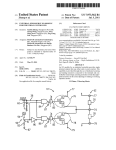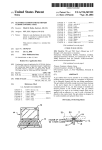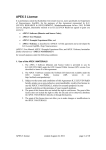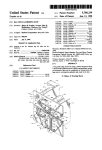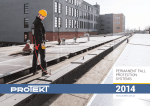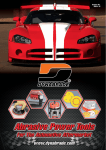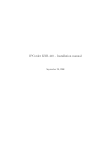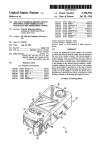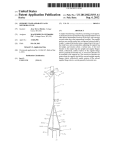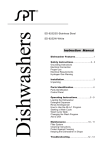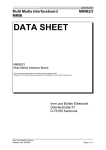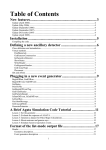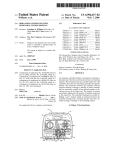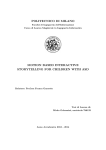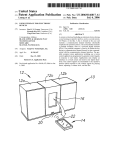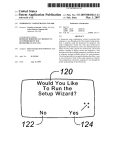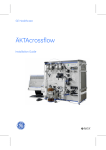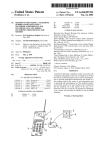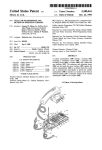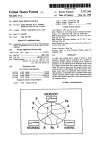Download Cushion for keyboard cursor control stick
Transcript
US005889508A Ulllted States Patent [19] [11] Patent Number: Slotta [45] [54] Date of Patent: CUSHION FOR KEYBOARD CURSOR Inventor: Mar. 30, 1999 OTHER PUBLICATIONS CONTROL STICK [76] 5,889,508 _ IBM ThinkPad 750 and 750C User’s Manual, pp. 4—27 Mark R. Slotta, 724 OakWood Dr., West Bloom?eld’ Mlch' 48322 through 4—29> dated Prior to invention Primary Examiner—l\/l ark K. Zimmerman Assistant Examiner—Ronald Laneau [21] Appl- N05 717,220 [22] Filed: Sep. 26, 1996 Attorney, Agent, or Firm—MacMillan, Sobanski & Todd, LLC [51] Int. C16 ..................................................... .. G09G 5/08 [57] [52] [58] US. Cl. ........................................... .. 345/161; 345/157 Field Of Search ................................... .. 345/161, 168, Acushion that can be attached to an existing Cursor pointing device (Control Stick) on a Computer or keyboard, or be 345/157, 160 _ References Clted [56] ABSTRACT integrally formed With the cap during manufacture. The cushion is ?exible enough to prevent tissue damage to the user’s ?ngers due to repetitive motions over an extended Us‘ PATENT DOCUMENTS period of use, yet ?rm 'enough to transmit 'the desired pressure to the control stick. The cushion designed to be 5,488,206 1/1996 Wu ........................................ .. 200/511 575687987 10/1996 Fran? ~~~~ ~~ 400/490 5570412 10/1996 Robmson ' " 345/163 used on an existing Control stick can be applied With an adhesive to a cap, or With a frictional ?t directly to the control stick. The cushions are designed to be easily 5,670,988 installed and re laced When Worn 5,701,142 5,708,562 5,712,660 9/1997 Tickle ........ .. 12/1997 Brown et a1. . 345/161 .. 345/168 1/1998 Agata et a1. .. 345/161 1/1998 Martin ................................... .. 345/161 p 23 Claims, 3 Drawing Sheets \ \\ F\ ' U.S. Patent Mar. 30, 1999 I---- 7- Sheet 1 of3 _ \NS\DE OF COVER" \5 WHEN cwswm 5,889,508 _ ; ' \1 U.S. Patent Mar. 30, 1999 Sheet 2 of3 2O 5,889,508 22 24 FIG. s2 34 33 34 ;F I G. 5 3O 416.6 U.S. Patent Mar. 30, 1999 Sheet 3 of3 5,889,508 PROVIDE A CURSOR POINTING DEVICE (CONTROL STICK) WITH A CAP 100 // HAVING A FIRST HARDNESS PROVIDE A CUSHION HAVING AN OUTER SURFACE OF A SECOND HARDNESS LESS THAN SAID FIRST HARDNESS —-—2OO ’/ 300 AFFIX THE SOFT CUSHION TO THE CAP —"::'IG.7 5,889,508 1 2 CUSHION FOR KEYBOARD CURSOR CONTROL STICK invention provides a “cushioned” cap for a control stick With a surface Which provides the needed ?nger to cap friction to easily use the control stick to move the cursor With a light touch, and Which is formed of a relatively soft material so that the cap does not irritate the body tissues of the user or BACKGROUND OF THE INVENTION This invention relates in general to a computer input device, and in particular to a cursor pointing device (cursor control stick), of a notebook-type portable computer or similar device. A ?nger mouse or cursor control stick, as used in this application, is a man-machine interface device Which con trols the motion of a computer display cursor. In particular, a control stick is a type of miniature joy stick Which is intended to be operated by the tip of one ?nger of the user. Typically, a control stick is mounted in a central location on a computer keyboard, such as betWeen the “G”, “H” and “B” keys on a standard “QWERTY”-type keyboard. The control stick has a position sensing mechanism Which detects horiZontal pressure in any horiZontal direction. The result in ?nger fatigue, even after periods of extended use. Various objects and advantages of this invention Will become apparent to those skilled in the art from the folloW 10 ing detailed description of the preferred embodiment, When read in light of the accompanying draWings. BRIEF DESCRIPTION OF THE DRAWINGS 15 cursor moves in a direction that corresponds to the direction of pressure exerted on the control stick and, in some FIG. 1 is a perspective vieW of a typical portable com puter employing a control stick having a cushioned cap in accordance With this invention. FIG. 2 is a side vieW, partly in section, of the control stick illustrated in FIG. 1. FIG. 3 is an enlarged sectional side vieW of the cap and the control stick illustrated in FIGS. 1 and 2. FIG. 4 is a side vieW of the cushioned cap illustrated in embodiments, at a speed that corresponds to the amount of FIGS. 1 through 3. pressure exerted on the control stick. The control stick FIG. 5 is a sectional side vieW of a second embodiment of includes an elongated shaft. The shaft of the control stick has a small diameter, thus alloWing the control stick to be 25 a cushioned cap in accordance With this disclosure. mounted betWeen the keys of the computer keyboard With FIG. 6 is a bottom plan vieW of the cap illustrated in FIG. out causing the placement of the keys to vary greatly from 5 that expected by an experienced user. A cap is typically FIG. 7 is a ?oWchart illustrating a method of manufac removably mounted on the upper end of the control stick turing a control stick in accordance With this disclosure. shaft, in order to provide an enlarged contact surface for a user to press against on the small diameter shaft of the DETAILED DESCRIPTION OF THE control stick. PREFERRED EMBODIMENT SUMMARY OF THE INVENTION Referring noW to the draWings, FIGS. 1 through 6 illus Some models of control sticks have a cap With a hard 35 trate a ?rst embodiment of a control stick, indicated gener ally at 10, according to this invention. The illustrated control stick 10 is a miniature joy stick, such as the TrackPoint, smooth surface, Which became slippery during use from perspiration or a build-up of natural body oils. Thus a user TrackPoint II, or TrackPoint III control sticks on notebook has to press their ?nger With relatively great force against the computers sold by the International Business Machines Corporation. HoWever, it Will be appreciated, in light of the folloWing disclosure, that the invention may be practiced on control devices other than such miniature joy sticks. cap to prevent their ?nger from slipping on the surface of the cap. The need to press hard on the cap makes control dif?cult, since the user cannot use the ?nesse and delicate movements typically needed for rapid, accurate cursor movement. Also, pressing hard on the control stick is physically tiring to the ?nger, hand and forearm muscles of a user, and caused irritation, in?ammation, and bruising of The control stick 10 is mounted in a keyboard 12 of a typical notebook-style microcomputer 14 having a pivotally 45 the ?nger tissue after a period of extended use. A period of extended use, as used in this application, a ?rst end (not shoWn) to the microcomputer 14, betWeen the keys of the keyboard 12. Acap 18 is removably mounted on the other end 21 of the control stick 10. The control stick 10 is usually made of a plastic material, and translates the means a period of use of more than about one hour, and generally more than four hours and less than tWelve hours. pressure on the cap 18 into a command to move a cursor on During such period of use, the user frequently manipulates the control stick. The frequency of manipulation of the control stick during a representative task, such as Word processing, Will typically be at least every ten minutes, on average, and may be much more frequently, depending on the particular task and the particular user. mounted video screen 15. The control stick 10 is mounted at a video display of the computer 14. The cap 18 of the control stick 10 is made of a relatively hard elastomeric material. At least a central portion of the outer surface 17 of the cap 18 is provided With an attached 55 Another type of a cap for a control stick has a textured cushion 20. The cushion 20 can be made of any resilient material that can be attached to the outer surface 19 of the cap 18. Examples Which may be suitable materials include outer surface. For example, one knoWn control stick is equipped With a cap Which is stippled With bumps Which are soft rubber, soft foam, and polyurethane foam. The preferred about the same siZe and spacing as the abrasive on 150 grit material for the cushion 20 is polyurethane foam such as the sandpaper. While this approach may help prevent the slip type used in expandable ear plugs. This type of foam product ping common With the earliest model cap, the textured cap is still irritating to the ?nger of a user When used extensively, even With the lighter touch alloWed by the textured surface. The uneven and relatively hard surface of such caps still can provides a surface that is relatively soft so as to not damage cause in?amed tissue, bruising, soreness and ?nger fatigue in users Which limits their ability to comfortably use such a control stick for periods of extended use. The present the tissues in the ?nger of a user during periods of extended use. Hardness can be characteriZed by measuring the force 65 applied to a given area Which is required to compress or de?ect a material a given distance. For example, a typical prior art cap, such as a cap supplied With the TrackPoint II 5,889,508 3 4 control stick, is made of a relatively hard elastomeric material. During testing, a probe having a contact surface of approximately 1 mm2 Was pressed against such a cap to cause the probe to de?ect the surface of the cap approxi mately 0.25 mm. A force of approximately 15 grams Was required to compress the surface of the cap inWardly this A recess 34 is de?ned in the cushion 30, Which generally conforms to the outer surface of the end 21 of the control stick 10. For example, as shoWn in FIG. 6, the recess 34 may have a square perimeter, if the end 21 of the control stick 10 is square in cross-section. The control stick 10 extends into the recess 34. Preferably, to install the cushion 30 onto the control stick 10, a suitable adhesive is applied to the upper end 21 of the control stick, to the interior surface of the small amount. In contrast, one embodiment of the cushion 20 of the present invention required a force of only 5 grams to be exerted by the probe to compress the surface of the recess 34 in the cushion 30, or to both the upper end 21 of the control stick and to the interior surface of the recess 34 10 in the cushion 30. The cushion 30 is placed on the end 21 of cushion 20 having a hardness Which Would permit a probe the control stick 10 so that the cushion 30 adheres to the end having a contact surface of approximately 1 mm2 to de?ect the surface of the cushion 20 by at least 0.25 mm When urged 21 of the control stick 10. Of course, the cushion 30 could also be af?xed to the control stick 10 by a resilient ?t by a force of 10 grams Would generally be acceptable. The preferred embodiment of the invention has a hardness such 15 betWeen the recess 34 of the cushion 30 and the end 21 of the control stick 10. The cushion 30 is comprised of a soft that only 5 grams of force is required to cause a probe having a contact surface of 1 mm2 to de?ect the surface of the material to permit use for an extended period of time Without cushion 20 by at least 0.25 mm. causing irritation to the ?nger tissue. It may be desirable to manufacture the cushion 30 With Preferably, the cushion 20 also provides a high coef?cient cushion 20 the same distance. According to the invention, a of friction With the user’s ?nger to permit easy positioning of the control stick 10. The polyurethane foam of the cushion 20 is yielding to a degree dependent upon the thickness of the cushion 20. The thickness of the cushion 20 can easily be modi?ed during manufacture to any desired thickness. Referring to FIG. 2, When the display 15 is folded doWn over the keyboard 12 for storage, as is typical for most notebook computers, the display 15 may contact the cushion 20. The cushion 20 is ?attened as indicated by the phantom line 19, but Will resiliently return to the position indicated by the solid outline of the cushion 20. The resiliency of the 20 the convex end 32 could be softer than the area of the cushion 30 surrounding the recess 34. The harder area 25 Where the convex end 32 is formed, and a second material 35 the mold at the area Where the recess 34 is formed. Accel erating agents, compatabiliZing agents, ?llers, mold release agents, and coloring agents can be introduced as Well, as Will be appreciated by those skilled in the art. SomeWhere betWeen the tWo ends 32 and 33, the ?rst and second 40 materials come into contact and become af?xed to one another. The cushion 30 Would, therefore, be a single structure formed from tWo different materials, having dif section. HoWever, the cushion 20 may have any suitable shape, such as that of a ?at-ended or holloW-ended cylinder. In the illustrated embodiment, the cushion 20 has a convex end 22, and a second end 24. The convex end 22 is the contact surface of the cushion 20, that is, the surface that the simultaneously into a cavity of single mold to form the cushion 30. For example, a ?rst material having relatively soft properties Would be injected in the mold at the area Which is harder than the ?rst material Would be injected in Referring to FIGS. 3 and 4, the cushion 20 is, preferably, a disk of material having a generally semi-circular cross surrounding the recess 34 Would assist in retaining the cushion 30 on the control stick 10 by maintaining its form, While the convex end 32 of the cushion could be relatively soft. One method of manufacturing the cushion 30 With por tions having different levels of hardness Would involve simultaneously injecting tWo separate types of material 30 cushion 20 alloWs the cap 18 to have an enlarged contact surface area and greater height above the keyboard 12 for increased comfort of the user, Without having to increase the spacing betWeen the screen 15 and the keyboard 12. It Will be appreciated by those skilled in the art that the cushion 20 Will preferably not be made from a material Which Would damage or stick to the display 15 if the display 15 contacts the cushion 20. portions having different levels of hardness. For example, ferent hardness characteristics When set or cured. For the purposes of the present invention, curing can be accom 45 user of the control stick 10 Will contact to move the control stick 10. The convex end 22 Will generally be a surface plished by using any suitable methods of solidifying or hardening a material, such as for example, by adding or removing heat, inducing a catalytic reaction, or containment providing a good frictional interface. In the preferred embodiment, the convex end 22 is a sealed, smooth, easily for a period of time to alloW hardening to occur. cleaned surface, such as a closed cell skin formed on a multiple areas With different levels of hardness Would be to polyurethane foam. The resiliency of the cushion 20 permits form the cushion 30 from a single material, but altering the the cushion 20 to be deformed and still provide excellent friction, even When the surface thereof is smooth. HoWever, if desired, the surface of the convex end 22 may be textured or knurled. The second end 24 of the cushion 20 Will be Another method of manufacturing the cushion 30 having setting or formation of the material so that the different areas have different hardness characteristics. This alteration of the formation process can be accomplished by varying the 55 temperature gradient surrounding the mold, creating minia attached to the outer surface 19 of the cap 18 on the control ture air pockets Within selected portions of the material, or stick 10. In the preferred embodiment, a suitable adhesive is by any other suitable manufacturing process. used to attach the cushion 20 to the outer surface 19 of the cap 18. FIG. 5 is a sectional vieW of a second embodiment of the As an alternate embodiment, it is contemplated that a cushion of the invention could be formed to completely encompass the cap 18 shoWn in FIGS. 2 and 3, except Where the shaft of the control stick 10 extends outWardly there cushion of this invention, indicated generally at 30. The cushion 30 is generally cylindrical and includes a convex end 32, and a relatively ?at end 33 opposite the end 32. Although in the illustrated embodiment the end 32 is convex, the end 32 may be formed to any suitable shape, such as a ?at or a concave surface, as may the end 22 of the cushion 20. 60 65 from. Such a cushion Would have a cavity therein Which includes a ?ange of material about an opening into the cavity. Such a ?ange of material Would restrict the siZe of the opening into the cavity to a diameter Which is less than the diameter of the cap 18, and thus retain the cushion on the cap 18, either alone or in combination With a suitable adhesive. 5,889,508 6 5 The opening into such a cushion could be resiliently expanded to slip the cushion onto the cap 18 during assembly, or When the cushion is replaced. 2. The cushion of claim 1, Wherein said soft material is selected from the group consisting of soft rubber, soft foam, and polyurethane foam. 3. The cushion of claim 1, Wherein the control stick has Although the preferred embodiment of the cushion 20 or a cap attached thereto, and said cushion is af?xed to said cap. 4. The cushion of claim 1, Wherein said cushion has a hardness Which requires a force of less than about 10 grams 30 is for use on a portable notebook computer 14, it is envisioned that the cushion 20 or 30 could be used on any keyboard or in any convenient location on any instrument requiring a control stick-like movement. It is contemplated that the cushions 20 or 30 of the present invention can be sold separately from a notebook-type portable computer as replacements or substitutes to the exerted on a probe having a contact surface area of about 1 square millimeter to de?ect the surface of said cushion a 10 distance of about 0.25 millimeter. 5. The cushion of claim 4, Wherein said cushion has a hardness Which requires a force of less than about 5 grams exerted on a probe having a contact surface area of about 1 square millimeter to de?ect the surface of said cushion a original control stick and cap con?guration. The cushions 20 or 30 can be sold in a kit form Which preferably includes the 15 distance of about 0.25 millimeter. necessary materials to af?x the cushions 20 or 30 to a control 6. The cushion of claim 1, Wherein said ?rst end includes stick of a computer. The kit may include a plurality of a portion Which de?nes said recess and is formed of a cushions 20 or 30 and a suitable adhesive material, such as material Which is harder than said soft material. a container of contact cement or a pressure sensitive self adhesive strip Which is pre-applied to the cushions 20 or 30. For example, if contact cement is supplied With the kit, the user simply applies a coating of contact cement to either the originally supplied cap 18 or the end 21 of the control stick 10, depending on the type of cushion 20 or 30 used. A coating of contact cement is also applied to the cushion 20 7. The cushion of claim 1, Wherein said soft material has 20 a closed cell skin. 25 8. The cushion of claim 1, Wherein said cushion de?nes a ?ange of material formed about said recess. 9. A cursor pointing device for a computer comprising: a housing; a control stick having an upper end and a loWer end, said loWer end attached to said housing; a cap attached to and enclosing said upper end of said control stick, said cap having an outer surface; and 30 a cushion attached to said outer surface of said cap, said or 30. The coatings of contact cement are then alloWed to dry. The cushion 20 or 30 is then pressed against the coated portion of the original cap 18 or control stick 10, thereby af?xing the cushion 20 or 30 to the control stick 10. FIG. 7 is a How diagram of a method of forming a cushion being formed of a soft material Which is suf?ciently soft to prevent damage to a computer display screen When said cushion is compressed there cushioned control 25 stick according to the invention. The method of forming a cushioned control stick may be sum mariZed as folloWs: In a ?rst step 100, a cursor pointing against. device (control stick) With a cap having a ?rst hardness is provided. In a second step 200, a soft cushion is provided 10. The cursor pointing device of claim 9, Wherein said soft material is selected from the group consisting of soft Which has an outer surface of a second hardness Which is rubber, soft foam, and polyurethane foam. less than the ?rst hardness of the cap (i.e., the cushion is softer than the cap). In a third step 300, the soft cushion is af?xed to the relatively harder cap. 11. The cushion of claim 9, Wherein said cushion has a hardness Which requires a force of less than about 10 grams 40 In summary, this invention includes: A control stick With a contact surface Which is relatively soft and non-irritating to the body tissue of a user. Acushion for a control stick, the cushion being softer than the control stick. distance of about 0.25 millimeter. 12. The cushion of claim 9, Wherein said cushion has a hardness Which requires a force of less than about 5 grams 45 exerted on a probe having a contact surface area of about 1 square millimeter to de?ect the surface of said cushion a distance of about 0.25 millimeter. 13. The cursor pointing device of claim 9, Wherein said cushion de?nes a cavity therein and an opening into said Acontrol stick cushion Which can contact a display screen of a computer display, deform elastically, and not damage the display screen. Acap for a control stick, joy stick, or similar device Which cavity, said cap being disposed in said cavity, said cushion including a ?ange of material about said opening Which releasably retains said cap in said cavity. is soft and non-irritating to the body tissue of a user during extended periods of normal use. In accordance With the provisions of the patent statutes, the principle and mode of operation of this invention have been explained and illustrated in its preferred embodiment. 14. The cursor pointing device of claim 9, Wherein said cushion has a closed cell skin. 55 practiced otherWise than as speci?cally explained and illus trated Without departing from its spirit or scope. cushion is formed With a ?rst convex end and a second concave end. What is claimed is: 60 computer, said cushion being formed of a soft material Which is suf?ciently soft to prevent damage to a com puter display screen When said cushion is compressed stick therein, and said second end of said cushion being is compressed thereagainst. 17. A kit comprising: a cushion adapted to be attached to a control stick of a being siZed to accommodate at least a portion of said control formed of a soft material Which is suf?ciently soft to prevent damage to a computer display screen When said second end 15. The cursor pointing device of claim 9, Wherein said cap is formed of a material that is harder than said cushion. 16. The cursor pointing device of claim 9 Wherein said HoWever, it must be understood that this invention may be 1. A cushion for a control stick of a computer, Wherein said cushion has a ?rst end and a second end, said ?rst end of said cushion de?ning a recess in said cushion, said recess exerted on a probe having a contact surface area of about 1 square millimeter to de?ect the surface of said cushion a 65 thereagainst; and an adhesive material for fastening said cushion to the control stick. 5,889,508 7 18. The kit of claim 17 in Which said adhesive material is contact cement contained in a container. 19. The kit of claim 17, Wherein said soft material is selected from the group consisting of soft rubber, soft foam, and polyurethane foam. 20. The kit of claim 17, Wherein said cushion has a hardness Which requires a force of less than about 10 grams eXerted on a probe having a contact surface area of about 1 square millimeter to de?ect the surface of said cushion a distance of about 0.25 millimeter. 8 21. The kit of claim 17, Wherein said adhesive material comprises a pressure sensitive adhesive strip ?xed to said cushion. 22. The kit of claim 17, Wherein said cushion has a closed cell skin. 23. The kit of claim 17 Wherein said cushion is formed With a ?rst conveX end and a second concave end.








